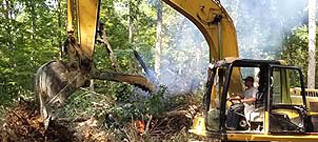WASHINGTON - Lexington Park in seaside St. Mary's County is one of the nation's fastest-growing "micropolitan" areas, expanding by 14.6 percent since 2000, largely on the strength of military growth, according to new Census Bureau reports.
The area, surrounded by the Patuxent River and the Chesapeake Bay, gained 1,986 people between 2005 and 2006, putting it among the top-gainers of 577 micropolitan areas in the country. The population may hit 100,000 next year if it continues at last year's 2.1 percent growth rate.
A micropolitan statistical area is defined by the Office of Management and Budget as a region with an urban cluster containing between 10,000 and 50,000 people.
The Defense Department's Base Realignment and Closure process created many new jobs in the region, especially in the mid-90s, spawning continued job growth in the area, said Mark Goldstein of the Maryland State Department of Planning. The area will continue to grow, he said.
The Patuxent Naval Air Station, which is based in Lexington Park, employs about 20,000 people, driving about 75 percent of the economy in St. Mary's County and providing roughly $3 billion to the state economy, said Hans Welch, manager of business development for St. Mary's County.
Southern Maryland is a fast-growing area in the state, and a very desirable bedroom community for people who work in the District of Columbia, but unlike neighboring Charles and Calvert Counties, many in St. Mary's County both work and live in the county, said Robin Finnacom, president of St. Mary's County Community Development Corporation, a non-profit redevelopment organization.
The average price of a home in St. Mary's County today is $337,501, compared with about $200,000 in 2003, Finnacom said.
The area, still surrounded by farmland, has a countryside charm and historical appeal, in addition to high tech jobs, she added.
The level of internal migration, or residents coming from other regions inside the U.S, into Lexington Park and Cambridge has been particularly high, although the Census Bureau statistics do not reflect the number of people coming in and out of the state yearly, or where they are moving.
Cambridge, Easton and Ocean Pines are state micropolitan areas growing at a steady pace, mostly due to high levels of internal migration.
The report also included information about metropolitan areas, and showed significant out-migration in the Washington area and Baltimore-Towson region.
The only metropolitan area in the state to show a decline in population was Cumberland.
It has been declining in population over the last decade, and it dropped below 100,000 in 2006. The region lost 426 people between 2005 and 2006, 0.4 percent of its population.
A combination of the loss of several nearby manufacturing plants, as well as the area's geography, are blamed for the trend downward, said John Frece, professor of urban studies and planning at the University of Maryland, College Park.
The area is divided by the Appalachian mountains and endures harsh winters, and the closure of major tire and fabric plants, once major industries in the region, struck a huge blow to the economy in the 1980s and 1990s.
"Times have changed . . . when they lost the economic base, they lost the population base," said Frece.
"We believe it's on the turn-around," said Cumberland Mayor Lee Fiedler. He sees the area's population stabilizing, based on new home water hookup statistics, and the census figures can't capture those recent trends.
The Hagerstown-Martinsburg, W.Va., area, which includes Washington County and Berkeley and Morgan Counties in West Virginia, has been the fastest-growing metropolitan region in Maryland, followed by the Salisbury area, which includes Somerset and Wicomico Counties.
There are 361 metropolitan areas defined by the OMB, which comprise 83.2 percent of the country's population.
Maryland Metropolitan/Micropolitan Population Estimates Metropolitan Areas 07/01/06 07/01/05 % Change Baltimore-Towson* 2,658,405 2,651,069 0.3 Cumberland/Mineral County, W.Va. 99,759 100,185 -0.4 Hagerstown-Martinsburg,W.Va. 257,619 250,836 2.7 Wilmington, Del.-Md.-N.J. 691,688 685,622 0.4 Salisbury 117,761 115,918 1.6 Bethesda-Gaithersburg-Frederick 1,155,069 1,147,814 ** Washington, D.C.-Va.-Md. 4,135,331 4,103,815 ** Micropolitan Areas Cambridge 31,631 31,351 0.9 Easton 36,062 35,630 1.2 Lexington Park 98,854 96,868 2.1 Ocean Pines 48,866 48,599 0.5
* Includes Anne Arundel, Baltimore, Carroll, Harford, Howard and Queen Anne's County, and Baltimore City.
** The change was .7 percent for the entire Washington-Arlington-Alexandria metropolitan area, which includes Frederick, Montgomery, Calvert, Charles, and Prince George's County, as well as surrounding Virginia counties and D.C.
Source: U.S. Census Bureau Population Division


